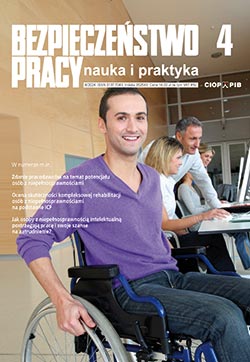Ammonia in cooling installations for the agri-food industry
Agnieszka Ubowska
Ammonia as a refrigerant has been used for more than 150 years. Its toxic properties justifiably raise concerns of users, but the available means of individual and collective protection, as well as the security measures and procedures can mitigate the risks associated with its use to a minimum. To prevent the uncontrolled release of ammonia from the refrigeration system in such branches as the agri-food industry is an important issue not only because of the health and lives of employees, but also because of the possible loss of stored goods. To facilitate the work of those responsible for the safety of refrigeration systems using ammonia as a refrigerant, a suggested checklist is presented in this paper. The questions included on the list can help not only ensure the safety of the installation but also meet the demands of legislators in this regard.
Ceramic nanomaterials – the potential occupational risk factors
Lidia Zapór
Nanomaterials use frequency has been rising in numerous industries, including the ceramic sector. This article summarizes the recent scientific reports on the toxicity of nanomaterials, including nanoceramics. An example of how to prevent potential risk of exposure during work with nanomaterials, is shown in the strategy of selecting protective measures depending on the level of hazard which the specific nanomaterial, drawn up by the HSE.
Minimum ignition temperature of dust layers as an parameter of the passive explosion protection systems
Marcin Grabarczyk
Article contains literature overview of experimental and computational (numerical) studies in the field of dust layer ignition from hot surface. Measurements of the minimum ignition temperature (MIT) of dust layer for medium-density fibreboard (MDF) scraps were performed with an results analysis. MDF is a basic material used for the furniture production and in carpentry. Research was conducted in accordance with method A of European Standard EN 50281-2-1, which specifically refers to industrial equipment with hot surfaces where dusts can form thin layers that are exposed to open air.
Paper also contains some of author’s insights on measurements aimed at determination of MIT of dust layers. Obtained results can be used for explosion protection in sawmills and carpentry workshops and are contribution to the knowledge of material science of wood industry.
Ergonomic of personal protective equipment
Grażyna Bartkowiak, Anna Dąbrowska
The main purpose of using personal protective equipment (PPE), including protective clothing, is to ensure worker’s protection against hazards that cannot be excluded or appropriately reduced by other means. However, using PPE can also have an unintended negative influence on the user, that can determine performing certain tasks and work in hazardous environment, as well as can have an impact on safety. Therefore, knowledge related to ergonomics principals is very important and should be included in a design and selection of PPE. It can assure their acceptability, and thus their using. On theother hand, ergonomic of PPE, and so their influence on the user, should be evaluated before their implementation to the market. It is particularly important in the case when PPE is the only protection of the worker. Therefore, the knowledge of ergonomic principles is significant during both the design, as well as evaluation of PPE. In the article, factors essential regarding ergonomics of PPE that should be included during the design (anthropometric, biomechanical, thermal, sensory and psychological factors) are presented.




























